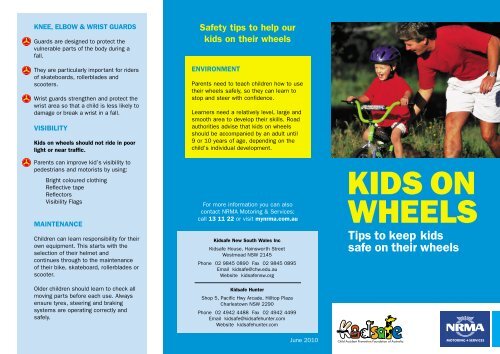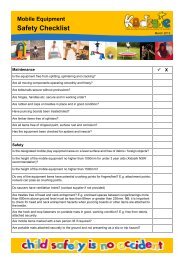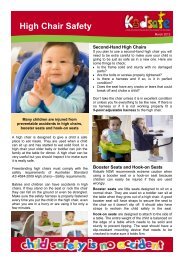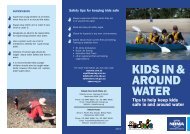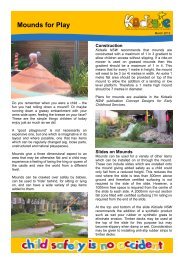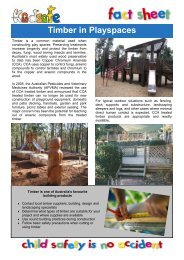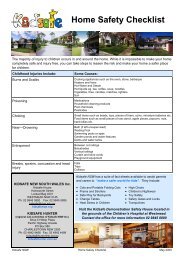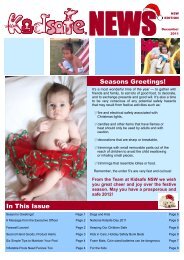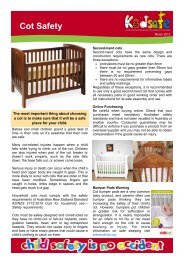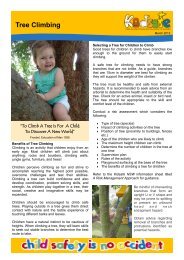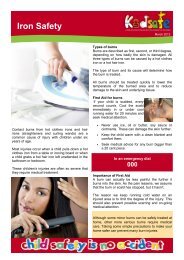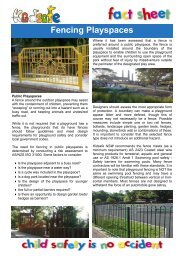Kids on wheels.indd - Kidsafe NSW
Kids on wheels.indd - Kidsafe NSW
Kids on wheels.indd - Kidsafe NSW
Create successful ePaper yourself
Turn your PDF publications into a flip-book with our unique Google optimized e-Paper software.
KNEE, ELBOW & WRIST GUARDS<br />
Guards are designed to protect the<br />
vulnerable parts of the body during a<br />
fall.<br />
They are particularly important for riders<br />
of skateboards, rollerblades and<br />
scooters.<br />
Wrist guards strengthen and protect the<br />
wrist area so that a child is less likely to<br />
damage or break a wrist in a fall.<br />
VISIBILITY<br />
<str<strong>on</strong>g>Kids</str<strong>on</strong>g> <strong>on</strong> <strong>wheels</strong> should not ride in poor<br />
light or near traffic.<br />
Parents can improve kid’s visibility to<br />
pedestrians and motorists by using:<br />
Bright coloured clothing<br />
Reflective tape<br />
Reflectors<br />
Visibility Flags<br />
MAINTENANCE<br />
Children can learn resp<strong>on</strong>sibility for their<br />
own equipment. This starts with the<br />
selecti<strong>on</strong> of their helmet and<br />
c<strong>on</strong>tinues through to the maintenance<br />
of their bike, skateboard, rollerblades or<br />
scooter.<br />
Older children should learn to check all<br />
moving parts before each use. Always<br />
ensure tyres, steering and braking<br />
systems are operating correctly and<br />
safely.<br />
Safety tips to help our<br />
kids <strong>on</strong> their <strong>wheels</strong><br />
ENVIRONMENT<br />
Parents need to teach children how to use<br />
their <strong>wheels</strong> safely, so they can learn to<br />
stop and steer with c<strong>on</strong>fidence.<br />
Learners need a relatively level, large and<br />
smooth area to develop their skills. Road<br />
authorities advise that kids <strong>on</strong> <strong>wheels</strong><br />
should be accompanied by an adult until<br />
9 or 10 years of age, depending <strong>on</strong> the<br />
child’s individual development.<br />
For more informati<strong>on</strong> you can also<br />
c<strong>on</strong>tact NRMA Motoring & Services:<br />
call 13 11 22 or visit mynrma.com.au<br />
<str<strong>on</strong>g>Kids</str<strong>on</strong>g>afe New South Wales Inc<br />
<str<strong>on</strong>g>Kids</str<strong>on</strong>g>afe House, Hainsworth Street<br />
Westmead <strong>NSW</strong> 2145<br />
Ph<strong>on</strong>e 02 9845 0890 Fax 02 9845 0895<br />
Email kidsafe@chw.edu.au<br />
Website kidsafensw.org<br />
<str<strong>on</strong>g>Kids</str<strong>on</strong>g>afe Hunter<br />
Shop 5, Pacific Hwy Arcade, Hilltop Plaza<br />
Charlestown <strong>NSW</strong> 2290<br />
Ph<strong>on</strong>e 02 4942 4488 Fax 02 4942 4499<br />
Email kidsafe@kidsafehunter.com<br />
Website kidsafehunter.com<br />
KIDS ON<br />
WHEELS<br />
Tips to keep kids<br />
safe <strong>on</strong> their <strong>wheels</strong><br />
June 2010
<str<strong>on</strong>g>Kids</str<strong>on</strong>g> love <strong>wheels</strong> - tricycles, bicycles,<br />
skateboards, rollerblades and scooters<br />
are all popular with kids. Depending <strong>on</strong> the<br />
wheeled toy and the child’s age and<br />
experience, there are a number of safety<br />
issues to c<strong>on</strong>sider.<br />
SKATEBOARDS and ROLLERBLADES<br />
These are very popular with older children<br />
and young teenagers.<br />
Ensure they use safety equipment that fits<br />
well and is worn every time.<br />
Rollerblades need to be a comfortable,<br />
firm fit <strong>on</strong> the child’s feet.<br />
Learners need a relatively level and<br />
smooth area to develop skills.<br />
Riders are required to observe road rules<br />
when using public areas.<br />
SCOOTERS<br />
Scooters are increasingly popular for all<br />
ages, from kids to adults.<br />
Most injuries to children using scooters<br />
are from falls.<br />
Ensure the scooter is suitable for the<br />
child’s age and size.<br />
Scooters with larger <strong>wheels</strong> are much<br />
more stable for smaller children.<br />
Check the c<strong>on</strong>structi<strong>on</strong> and stability of<br />
folding mechanisms regularly.<br />
Teach the child to operate the braking<br />
system. Scooter speed should match the<br />
child’s age and ability.<br />
TRICYCLES and BICYCLES<br />
Most injuries are from the child losing<br />
c<strong>on</strong>trol, so ensure the bike or trike is the<br />
right size for the child.<br />
Both feet should touch the ground when<br />
seated.<br />
Children should be able to reach the<br />
handlebars comfortably when seated.<br />
Brakes should be within reach and<br />
operable.<br />
Check that it is stable.<br />
Provide a safe area to ride — away from<br />
slopes, stairs and bumps.<br />
Safety equipment is essential and should<br />
include:<br />
Brakes<br />
Lights<br />
Reflectors<br />
Bells<br />
Visibility devices (reflective tape,<br />
flags, etc)<br />
Essential Safety Equipment<br />
Parents need to ensure children have<br />
safety equipment that fits well and is<br />
worn every time.<br />
HELMETS<br />
Helmets are the most important piece<br />
of safety equipment and protect<br />
children’s heads in the event of a fall.<br />
They need to be worn every time.<br />
Make sure the clip is fastened and it<br />
fits correctly.<br />
To check the fit of the helmet, push<br />
gently with the heel of the hand against<br />
the fr<strong>on</strong>t. If it fits correctly it will have<br />
limited movement.<br />
Parents need to make it clear that<br />
children can not use their wheeled toy<br />
without wearing their safety gear.<br />
C<strong>on</strong>tinued over


